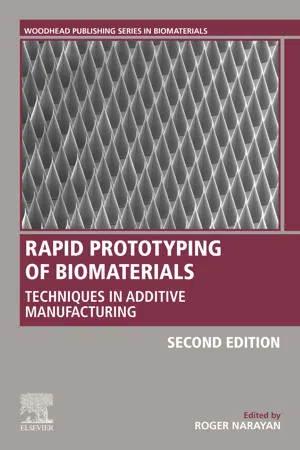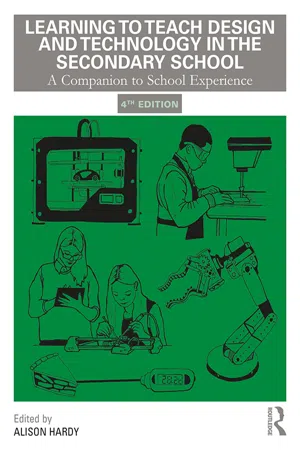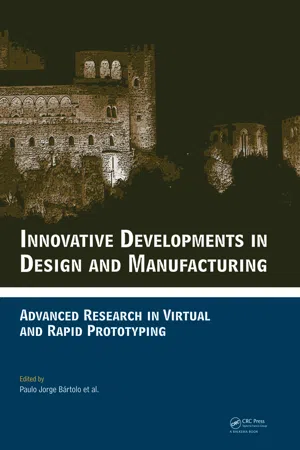Technology & Engineering
Rapid Prototyping
Rapid prototyping is a method used to quickly create a physical model or prototype of a product using computer-aided design (CAD) data. It allows for the rapid iteration and testing of designs, helping to identify and address potential issues early in the development process. This approach can significantly reduce time and costs associated with traditional prototyping methods.
Written by Perlego with AI-assistance
Related key terms
Related key terms
1 of 4
Related key terms
1 of 3
7 Key excerpts on "Rapid Prototyping"
- Yoseph Bar-Cohen(Author)
- 2018(Publication Date)
- CRC Press(Publisher)
4 Current Capabilities and Research Trends in Rapid and Virtual PrototypingSriram Praneeth Isanaka and Frank Liou4.1 Introduction4.2 RP: Steadily Evolving into Rapid Manufacturing4.2.1 RP Techniques That Produce Nonfunctional and Partial Functionality Parts4.2.2 RP Techniques That Produce Functional Parts4.3 VP: Actively Aiding RP Processes Become Alternative Manufacturing Techniques4.3.1 VP Techniques to Study RP Phenomena and Improve Technologies4.3.2 VP to Promote Better Processing Planning and Control in RP4.3.3 VP for Part and Process Qualification4.4 Final ThoughtsAcknowledgments References4.1 IntroductionThe ability to prototype parts has been a tremendous boon to engineers across the world for many generations. Physical models and prototypes offer engineers an avenue for observation, discussion, redesign, refinement, and risk mitigation (Viswanathan et al., 2014) and can then be effectively employed to improve the form, fit, and aesthetics of any design. In the past, prototypes were made of materials like wood, plastic, and foam, which enabled engineers to construct them in a short amount of time. In rare cases, these rapidly constructed and limited functionality products were even employed in feasibility studies to prove the viability of specific concepts and mechanisms. Previously, the iterative redesign and refinement based on the assessment of these physical prototypes were considered as a viable design strategy.The advent of computer-aided design (CAD) though has led to the creation of a suite of supplementary tools for engineers, namely, virtual prototyping (VP), that competes with physical prototyping as an alternate design strategy. Many engineers have embraced virtual prototypes’ potential, as substitutes for physical prototypes, due to the comparatively less investment needed in terms of time and money (Zorriassatine et al., 2003). To address this need, research and software development have led to the evolution of parallel branches of VP in the areas of design (computer-aided engineering), manufacturing (computer-aided manufacturing) and assembly (Lin and Farahati, 2003), performance analyses (Firat and Kocabicak, 2004) (finite element method [FEM]), and planning and resource management (supply chain management and enterprise resource planning). While VP started off as a component-level assessment technique, currently, VP packages exist for microstructural, assembly-level, and even factory-level assessment, thereby bridging the gap between the microscopic and macroscopic scales. Many engineering software packages of today offer engineers control of their design and the ability to plan for refinement and performance assessment beginning from inception (Pang et al., 2006) through to final manufacture and assembly. These suites of VP software, also known as product lifecycle management (PLM) software, can significantly reduce lead time and the prototyping and performance assessment budgets needed to introduce a product to the market. Researchers of today are even envisioning geographically distant digital factories (Burns and Howison, 2001) that can be controlled by PLM software (Tay et al., 2001) with the ability to not just conceptualize and assess performance but also tailor material characteristics in real time and plan for final assembly and testing. VP’s capability has led to the decrease in the number of prototypes needed for design development. This chapter will highlight the current capability of VP and identify its research trends and possible future directions.- eBook - ePub
Mastering UX Design with Effective Prototyping
Turn your ideas into reality with UX prototyping (English Edition)
- Apurvo Ghosh(Author)
- 2023(Publication Date)
- BPB Publications(Publisher)
In 1987, Carl R. Deckard, a researcher at the University of Texas, came up with an innovative idea. He pioneered the field of layer-based manufacturing and came up with the idea of creating a model layer by layer. He used laser light to combine 3D models to combine layers of metal powder into a solid sample. Deckard developed this idea in a way called ‘Selective Laser Sintering’. The results of this method are encouraging. The history of prototyping is completely new and modern. However, the prototyping technique has been a revelation of late and has grown rapidly to deliver amazing results.The innovation, findings, and research of Voelcker and Deckerd have given a lot of momentum to the new Rapid Prototyping industry known for its fast-paced design or product design. It has bought about a radical change in the design and manufacturing process. Although there are many references to those who pioneered Rapid Prototyping, the industry gives credit to Charles Hull for the manufacturing of Apparatus for Production of 3D Objects by Stereolithography. Charles Hull is also known in the industry as the Father of Rapid Prototyping . Rapid Prototyping has evolved a lot over the years. Designers create ideas on paper and after getting a sign-off, the prototypes are created using software. These softwares allow you to make the necessary changes and help you create a physical prototype that is somewhat close to your product and a proper 3D object.Provotype versus prototypeNot everybody has the chance to live in the future. Our role as designers and innovators is to assist clients and their customers in breaking away from the status quo. We always try to come up with new ideas about how to envision and develop a sustainable tomorrow. Provotyping is one of the ways that helps you achieve this. What is a Provotype? It is unrealistic and helps you in refining designs by aiding you to create the most unusable or provocative iterations. It is an excellent tool that helps in:- Eliciting discussions
- Visualizing and concretizing ideas
Simply reading about thoughts, stories, and concepts allows our minds to imagine them based on our own perceptions and aspirations. Since we all have diverse experiences and visualization skills, our aspirations are often not fulfilled by reality. - eBook - ePub
Corporate Innovation
Disruptive Thinking in Organizations
- Donald Kuratko, Michael Goldsby, Jeffrey Hornsby(Authors)
- 2018(Publication Date)
- Routledge(Publisher)
27 Capturing the anticipated look of the product can be further attained by putting together a more realistic version of the prototype by adding vinyl overlays, paint for the overall appearance, and buttons and accouterments from other products.Rapid Prototyping TechniquesIn centuries past, craftsmen carefully built prototypes using hand tools and machine tools, a process that required much skill and time. However, modern technologies are available today for Rapid Prototyping (RP), which allow a three-dimensional prototype to be constructed in considerably less time, and without demanding a high level of technical skill. Rapid Prototyping typically employs a computer-aided drafting (CAD) program that allows the user to create virtual spheres, rectangular prisms, and other solids. These images are repositioned and scaled, duplicated and arrayed, squashed, twisted, or folded. Sometimes they’re joined together or subtracted from one another. The resulting digital object is then saved in a format that can be transferred to a prototyping machine for an actual physical “build.”Rapid Prototyping technologies can be classified as either subtractive, where we cut away unwanted material, or additive, where we build a model, typically by stacking up different layers of materials, each a horizontal cross-section. One additive process is laminated object manufacture (LOM), where one layer of a material is placed on top of another; these may be paper or paperboard with glue on one surface, for instance, each piece the exact shape of a horizontal cross-section at a different elevation within the object. This same “slicing” is used for most other additive RP technologies. Stereolithography (SLA refers to StereoLithography Apparatus) is a process where photo-curable plastic resin is drawn from a vat to selectively place a thin layer of the liquid down where it’s cured by a laser beam, one layer at a time; this polymerizes and solidifies the part, growing it from the bottom up. Another RP additive technology is fused deposition modeling (FDM), where a spaghetti-like strand of material is heated and extruded onto a platform to build the first layer of a product; a second layer is extruded on the first, and so on until the entire object has been built. Solid object printing (SOP) is a technique where print heads are used to selectively place material. In some instances, we can use a plaster-like powder and have a colored or clear binder agent printed on a thin layer of the powder, on which is wiped the next layer of the powder until the entire part is built. In other instances, we can have the build material itself, sometimes a wax, placed down by the same mechanism seen in some printers. Selective laser sintering (SLS) uses a laser to make certain areas of powder, often plastic or metal powder, stick together. Each of these methods has specific advantages and disadvantages, so you’ll want to consult an expert in selecting the one that’s best for your project. In general, while the specialized materials are somewhat costly, prices for Rapid Prototyping machines have dramatically decreased over the last decade. - eBook - ePub
Rapid Prototyping of Biomaterials
Techniques in Additive Manufacturing
- Roger Narayan(Author)
- 2019(Publication Date)
- Woodhead Publishing(Publisher)
1Introduction to Rapid Prototyping of biomaterials
Chee Kai Chua; Kah Fai Leong; Jia An Singapore Centre for 3D Printing, School of Mechanical & Aerospace Engineering, Nanyang Technological University, SingaporeAbstract
Rapid Prototyping (RP), also known as additive manufacturing or three-dimensional (3D) printing, is a group of evolving technologies that create 3D objects additively in a layer-by-layer manner from a predefined 3D computer model. This chapter first introduces the definition of RP, followed by a description on the basic process, classification, and representative RP systems. Finally the chapter discusses how RP can be used for processing biomaterials and suggests possible research directions in the future. This chapter intends to give readers a general view on RP of biomaterials.Keywords
Rapid Prototyping; Additive manufacturing; 3D printing; Biofabrication; Tissue engineering; Bioprinting1.1 Introduction
Rapid Prototyping (RP) is a group of dynamic and evolving technologies that create three-dimensional (3D) objects additively in a layer-by-layer manner from a predefined 3D computer model. The origin of the idea of RP can be traced back to the 1890s, but a physical RP system is commercially launched only in the 1980s (Chua and Leong, 2017 ). The development of RP is closely tied with the development of computer and software industry. In particular the development of computer-aided design (CAD) plays a critical role in the emergence of almost, if not all, of today’s RP systems. The original primary function of RP systems is to fabricate prototypes within a short period of time (usually within hours or days) to accelerate product development and address increasing product complexity. However, after three decades development, the applications of RP extend far beyond building prototypes. In fact, it has been adapted to meet the needs from a variety of industries, including design, manufacturing, automotive, aerospace, biomedical engineering, jewelry, and coin. Currently, RP is rejuvenating itself in the defense and manufacturing industry, especially with the establishment of America Makes, also known as National Additive Manufacturing Innovation Institute (NAMII), in the United States (The White House, 2012 - eBook - ePub
Learning to Teach Design and Technology in the Secondary School
A Companion to School Experience
- Alison Hardy, Gwyneth Owen-Jackson, Alison Hardy(Authors)
- 2020(Publication Date)
- Routledge(Publisher)
Rapid Prototyping is used in fabrication techniques in manufacturing via CAD/CAM (Baek 2008). The purpose of Rapid Prototyping is to model possibilities quickly by building an inexpensive series of mock-ups so designers are able to obtain early feedback from which they may respond to user requirements (Tripp and Bichelmeyer 1990). In schools, you will find CAM machinery, laser cutters and 3D printers available for pupils to realise their ideas in 3D form quickly and effectively as part of the iterative design process.Failure
It is perhaps an unusual choice of design strategy but it is through failure that pupils learn to improve their design ideas. Without failure they may struggle to appreciate what success is, so it is important that there are opportunities for failure to occur in the designing process. Pupils will benefit from seeing examples of failed designs and suggest how the failure could have been avoided or how it can be corrected. Showing pupils how a design might fail to illustrate the problems with a design will help them develop their critical thinking skills in analysing and evaluating an idea or prototype. Acceptance of failure in the design process should give pupils the confidence to take creative risks in their design work as they won’t always expect the outcome to be ideal or fully functional first time. Supporting pupils in this process with positive feedback and constructive criticism is vital to encouraging the germ of a good idea to grow and develop into a quality prototype outcome. The problem, as Kimbell (2000, p. 3) notes is ‘none of us will take risks with a highly creative idea if we think that any possible failure is likely to be criticised, dammed and rubbished by those who hold power over us’.The only real failure when designing is when you cannot identify why a design is not working and make changes or modifications to improve it. Often the most successful projects are those that are developed from a failed prototype as there may be clear evidence of the critical and design thinking that has been undertaken to reach a successful conclusion. - eBook - ePub
Innovative Developments in Design and Manufacturing
Advanced Research in Virtual and Rapid Prototyping -- Proceedings of VRP4, Oct. 2009, Leiria, Portugal
- J. N. Reddy(Author)
- 2009(Publication Date)
- CRC Press(Publisher)
The technologies available in the market adopt a dedicated process planning software approach. This may speedup the system learning curve, but it can limit the expert users when trying different strategies and parameters other than the canned ones. This work presents today’s development stage of a RP software called Rapid Prototyping Process Planning System (RP 3). Its main goals are to offer more autonomy on the processing parameters, considering different RP technologies, and to allow process development. Some studies are presented to demonstrate the system performance and potential. Relatively complex geometries can already be processed with good results. Additionally, some main limitations in the development are discussed. 1 INSTRUCTIONS Rapid Prototyping (RP) is a manufacturing process based on a layer by layer addition principle. In general, a software for RP process planning has to read the part geometry, usually in STL (STereoLithography) format, slice it electronically, generate the information to process each layer and send the data to the RP machine (Beaman et al. 1997, Chua et al. 2003). There are many RP processes in the market, amongst them: Fused Deposition Modeling (FDM), which deposits an extruded polymeric filament and Selective Laser Sintering (SLS), which works with a laser beam to selectively sinter powder material (Beaman et al. 1997, Kai et al. 2003). The RP process planning has some stages which are generic to all layer manufacturing technologies and some that are dedicated to a specific process. The technologies available in the market adopt a dedicated process planning software approach. This may speedup the system learning curve, but it can limit the expert users when trying different strategies and parameters other than the canned ones. The option to tune the process becomes more important for a functional prototype or in a Rapid Manufacturing context (Hopkinson et al. 2006) - eBook - ePub
- Mohamed Zairi, Richard Duggan(Authors)
- 2010(Publication Date)
- Routledge(Publisher)
If CAE can be developed to a mature level, then the traditional iterative approach to product development can be reduced to a process involving fewer prototype series. Ultimately, with fully mature CAE tools, it would in theory be possible to go directly into production without physical prototypes, since all the development would have taken place by computer simulation. It is unlikely, however, that this will ever happen since even small changes bring a potential for unknown and unpredictable responses and, therefore, some preproduction prove-out phase would be required.A rationalized product development programme using computer-aided design techniques may well be as shown in Figure 1.9 .Figure 1.9 A development approach using computer-aided engineeringThe use of computer-aided design processes brings additional benefits. Photo quality images of a part or assembly can be produced easily, thus helping the design process, and allowing subjective judgements on appearance to be made. Stereo lithography can be used to automatically generate physical replicas of parts and assemblies, which again can assist with the design and development process.This latter process provides a major efficiency gain and is time saving, since physical models of a part can be made available directly from the computer in a matter of minutes or hours. This effectively bypasses the procurement and manufacturing processes, and all the bureaucratic delay that usually surrounds them.Could process innovations stifle product innovation?
Process innovation can provide a route to producing better products, more quickly and at lower cost. However, it could have the undesirable side effect of stifling product innovation.The rationale for this proposal is that shorter development lead times encourage more conservative design approaches; it is easier to deliver familiar technology than it is to develop new technology. There is a lot less learning to do, and fewer unexpected issues will appear to thwart the development process.The issue here is how far existing knowledge and experience is to be extrapolated. Working within known boundaries of design provides for the lowest level of risk in the development of the new product. As the designer moves away from the familiar into the unfamiliar so the risk increases, and it does so rapidly.
Index pages curate the most relevant extracts from our library of academic textbooks. They’ve been created using an in-house natural language model (NLM), each adding context and meaning to key research topics.
Explore more topic indexes
Explore more topic indexes
1 of 6
Explore more topic indexes
1 of 4






